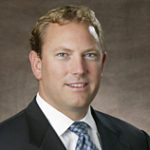
Leading Others to Victory is a Win for Scott Spalding, executive vice president for PIMCO. Scott leads a team in developing PIMCO’s asset management business among private banks and trust companies. He has been with PIMCO for 11 years. A former guard and co-captain of the UCLA football team, he is married and has three children.
Interview by Deborah Lazaroff
How did you meet Bob and begin working with him?
Bob and I met in 2005 when he was here at PIMCO for a coaching engagement.
Bob worked with me and several of my colleagues in 2005 – 2006, and afterwards we remained in touch several times a year. Over the past year we began working together on the development of my team.
What is it about Bob and his coaching that you felt would be especially helpful to your team?
There are a couple of important elements in his coaching. One is the level of experience that Bob has with different types of organizations, as well as his specific experience with financial institutions and, more specifically, asset management firms. But even more important is his understanding of the dynamics of managing client relationships and selling. Bob is an expert in communication, especially when it comes to helping people recognize the benefits of a product or service. It’s those fundamental skills that are often the most difficult to keep front and center, and I believe that when you work with highly technical products, there’s a tendency to lose focus on that particular skill set. That’s one element of Bob’s added value. The other is his intelligence, his wit, and his ability to work with a broad range of individuals. Asset management tends to attract highly intelligent, driven people, and it takes someone in that realm—with that same latitude and ability—to work with such individuals. Bob has that skill set, which gives him a lot of credibility.
Based on your personal experiences, what are some of the leadership challenges you’re facing in building your team?
PIMCO’s Bank Trust business has been successful and we’ve enjoyed phenomenal growth. We want to maintain this growth, but like many organizations the business unit has a lifecycle—development, growth, maturity, and decline.
Would you say that you’re moving from growth into maturity?
We are currently in the growth phase and our challenge is determining how to extend that phase. We have a successful business, but we’re examining the horizon to determine future opportunities for growth. We can do what we did yesterday and likely it will work tomorrow, but sustainable growth is achieved by progression, not following the status quo. In our case, the next phase of growth requires a different skill set. That’s the first challenge.
To determine how best to extend the growth phase.
That’s right. The second leadership challenge is to adjust our approach and emphasize a different skill set than the one that’s brought us where we are now.
Emphasize is the key word, not change, because as investment professionals and business people it is necessary to have a diverse skill set. What brought us this far and what will continue our growth are two different approaches. In asset management, a high degree of value is placed on investment acumen. Due to the highly technical nature of the products and the fact that clients in general are less familiar with bonds than stocks, it’s easy to fall into the role of being an investment specialist.
Which involves a lot of esoteric information. But the key to keeping growth momentum is in building relationships.
That’s right. We developed our business based on investment acumen and the banks’ move from in-house management to using outside money managers.
We’ve been successful in placing our products, gaining sales, servicing our clients and helping the business grow. We’re now at the point where we must change our approach to broaden our distribution relationships. This involves three key elements. The first is to expand relationships with key decision makers across our client organizations.
The second is to access untapped channels of distribution within our client organizations. Banks manage money for high net worth individuals, for corporations, for municipalities, and other types of investors. Our growth has come typically from their trust investment department, but there are opportunities in other channels of distribution as well.
And the third is broadening the potential set of solutions we bring to our clients. One example is our expertise in alternative investment products.
What is your biggest challenge as a leader?
My biggest challenge as a leader is to help people realize the necessity for change.
This stage in our business’ lifecycle requires that we emphasize our business skills as much as our investment skills. We need to strike a balance between the two. The key is to recognize that the investment product itself is not an objective; it is a tool to reach an objective. That means thinking of investment products as instruments to help clients realize a benefit, whether it’s a comfortable retirement, a sense of security, etc. Ultimately this means understanding the dynamics of our clients’ businesses, and delivering PIMCO’s capabilities to help them achieve their objectives. That’s the primary leadership challenge, because it’s too easy to slip into the role of solely an investment expert.
Right. The tech-talk.
The tech-talk. Instead, we want to discuss tools that help solve problems, because that’s what we truly represent to the client. But this is a very different way of seeing things.
Changing that outlook is quite a challenge. Are there any particular approaches you’ve taken that Bob has instigated to emphasize the personable aspect in helping your team develop that mindset?
Yes. We’re focusing on broadening our contacts within our client organizations and discussing the benefits of the products.
Essentially you’re expanding your relationships to include other contacts who participate in the decision making process.
Exactly. Research professionals continue to be our primary contacts, however, as our business grows, it’s natural for us to be in contact with others within a client organization. For example, we’re connecting with those individuals who are endusers of the products, who work with clients, and who manage the overall business.
As we broaden our relationships we increase our understanding of the advantages we can provide to our clients. We learn to speak in their language and understand how we can best help them. For example, many clients value PIMCO’s intellectual capital. We have some of the best people in the investment marketplace. For clients who appreciate PIMCO’s thinking, my team and I serve as their envoy, understanding their needs and working with our PIMCO colleagues to leverage PIMCO’s intellectual capital to help them achieve their goals.
And that’s a shift, viewing ourselves as a liaison rather than the product expert.
We’re more valuable to our clients in understanding the world in which they operate, their needs, and how we can make PIMCO’s tremendous set of resources available to help them achieve their goals. This is the role my team and I are developing. It definitely requires investment expertise, but it’s also a shift to much closer, more personalized relationships with our clients.
What do you believe are the skills and aptitudes required to make that shift?
I think there are several core skills—and that’s an acronym—C-O-R-E. The “C” is for Communication, which incorporates two elements: one is to define our role for our clients and our PIMCO colleagues, and to ensure we gain buy-in for that role. Second, we need to transition from talking about products to talking about benefits. That means developing a higher level of communication focusing on the benefits to the client.
The “O” is for Organization; the critical business skills of setting objectives, prioritizing opportunities, time management, and measuring our progress.
“R” is Resourcefulness, and this is a critical element because it involves the tremendous amount of intellectual capital in PIMCO. Our objective is to know when to bring in the specialists—not to spend our valuable time being the specialists. This means maximizing PIMCO’s resources and then helping our colleagues perform at their best when working with PIMCO clients.
The “E” is Evaluation; knowing yourself and how you’re progressing. It’s a situational awareness in which you’re able to identify your successes and are aware of the behavior driving your accomplishments. It’s also an understanding of the difference between the way you used to do things and the way you’re doing them now. It’s articulating what you’ve learned, and passing along that knowledge to others.
It’s a very different approach, because it’s easy to say this financial tool will work for this situation, and this bond portfolio has certain risks, but how easy is it to listen to your clients to find out precisely what they need?
It’s difficult to move from talking about the attributes of a product to discussing its benefits. It’s interesting to discuss the price movements in a particular sector of the bond market and what influences that price movement; that’s all very important. But our clients are focused on the contribution of that particular investment solution to their overall portfolio. And they’re most interested in the desired benefits the overall portfolio produces for their end-clients, high net worth individuals or institutional investors.
That’s it in a nutshell, and it’s often difficult for highly technical people to find that mindset.
Investment professionals are sophisticated folks who live within a forever evolving industry. They genuinely have a passion for investing. In fact, it’s very difficult to be in this business unless you have a passion for it. So focusing your mindset on core business skills—which may be theoretically considered less fluid—can be a challenge.
Right. Because you’re looking outside yourself rather than just looking at your individual skills and font of knowledge. How has Bob’s coaching helped you and your team?
Bob has helped us to establish a set of objectives and a game plan to identify the particular skills we each want to improve. He takes the time to get to know people and understand the benefits they’ll appreciate, what each particular individual considers a win, and what he or she wants to improve. Bob understands that it’s not simply about our business objectives. It’s also about the personal objectives of each team member, the specific elements of their game each wants to improve, and how these are all an important part of obtaining the team’s objective.
How has your team responded to the training? Are they enthusiastic about it?
Yes, they are. It’s been an evolution for us, and it’s had quite an impact on my view about leadership. I’ve learned that my prior approach—leading by example—only goes so far because it means, “do as I do.” And that involves two major assumptions: first is that the approach I’m using is the right one, and second, that this approach will work for everyone. These are two very poor assumptions, and I’ve realized that leading by example has limitations. We’re good investment people, but the CORE skills we’ve discussed are currently coming second, and we need to make them our primary focus. We want to be the ambassadors for PIMCO by listening to our clients to determine precisely the right tools to help them achieve their goals. That’s what’s important to our clients.
Bob has helped us to define these issues, gain buy-in from the team, and develop a game plan. And that in turn has helped me to lead in a very positive way.
What are some of the things you do as a leader to get your team’s buy-in?
It’s very simple, and it’s a key aspect of what Bob Mobley is all about, which is speaking to the benefits for each individual. This involves understanding the people who work for you, their business interests, and what they want to achieve in their careers; then helping them to understand what’s in it for them.
That’s very key to leadership.
It’s key to leadership, and to achieve our goals each of us has to realize that there is a reason to change, that we need to change and that it’s in our best interest to change.
Exactly. Now before you came to PIMCO, were there particular skills you gained that you believe have helped you become the leader you are now?
I played college football at UCLA. I was also one of the team captains, an offensive co-captain. On a football team you have a specific assignment for each play. Everyone has his assignment, and it’s most important for you to get your job done. Then there’s the teamwork element of the positive externalities you can lend your teammates, and more important, how you go about getting prepared. In football, you spend the entire year preparing for 12 games. So it truly is an exercise in preparedness. I believe my ability to demonstrate the discipline and focused mindset necessary to win is where my leadership by example came from.
And likely the planning and organization.
Actually, I learned quite a bit about planning and organization as a wet-behindthe-ears college grad starting as a sales associate in the group health insurance business. I worked my way through that organization to become a senior salesperson. Then I went to business school. This time allowed me to build my skill set and begin a career in an industry I’m passionate about: investing. With my sales experience and MBA, I started again as an internal salesperson. A couple of years into my career I was given the opportunity to tell my bosses what I wanted to do over the next 12 months and where I believed the opportunities lay.
I responded to that inquiry with a business plan to develop a channel of distribution we had not yet proactively pursued.
So you came to the table as a leader of this team with a solid background in sales, marketing and team-building in terms of being a co-captain of the UCLA football team. But you also had a vision to create a plan to develop more business. And that’s important. That’s a key principle of leadership: to have a vision.
You may be giving me more credit than is due. I would say that I sensed a great opportunity within the marketplace. I didn’t have a grand vision of the way everything would turn out.
Having a vision doesn’t mean you necessarily know how things will turn out. Having a vision is the ability to see or recognize opportunities that others might not. That is extremely important in a leader.
It helps to have a nose for opportunity, and it also helps to stay in the game.
We’ve been talking about the coaching role, but I have a player role as well. I have another, entirely different set of responsibilities where I’m the salesperson, selling PIMCO’s hedge funds and private equity funds, which are the most technical in nature and the hardest to sell. So I do that, too!
Which has the added value of keeping you on your toes and keeping your senses right on target, which is also essential to good leadership.
I would agree. Honing your sense for opportunity and competitiveness is always beneficial. But I’ve realized that helping others be their best is perhaps the greatest skill of all. If I can develop that skill, that will be my very best attribute.
That will be your greatest accomplishment as a leader.
It will be my greatest accomplishment, and the most satisfying. There’s nothing better than to help everyone win.
That’s something Bob teaches, because that’s how he sees life.
It is how Bob sees life, but he helps you to come to that conclusion yourself. And talk about a gift! Thanks to Bob, I can see that clear benefit through my own eyes and it feels like a personal epiphany.
Now that you have a personal connection to it, it’s become not just a concept, but a reality. Which is very much an epiphany.
Realizing that helping others benefits our clients, our business, and each of us personally is striking. That requires leadership. As Bob says, “there’s management and there’s leadership.”
Right. They’re two completely different concepts.
They’re two different concepts, and leadership is the tough one. We sometimes think of leadership as leading by example, but in reality it’s understanding with whom you’re working, what they’re trying to get out of their business life, how they view things and what they see as wins. That’s actually much harder.
You’ve pretty much answered my next question, about what you considered were the most valuable things you’ve learned about leadership both personally and professionally. It sounds to me that the reward of helping other people is what’s most valuable to you in what you’ve learned.
It is, but I’ll be the first to say I’m a work in progress.
Everybody is.
True. I learned that the “lead-by-example” concept was a miss for me, because I didn’t spend as much time and I didn’t help people as much as I might have. We were building this business, and I was the driver, the player/coach. I like playing, but coaching is becoming even more satisfying. I sense the opportunity, and the competitiveness within me recognizes the challenge, but I also see the benefits and the virtues. That’s very different. It’s become much less about me, and much more about the team. That has truly been the epiphany.
What would you say is the number one benefit Bob offers?
What truly stands out is the time Bob takes to understand each of his clients. It’s a process, and it takes a tremendous amount of time. With Bob, that’s time well spent because he listens and offers great ideas, and he does so in a way that makes it easy to recognize their inherent value. Plus you’re never on the clock with Bob.
That’s a good way of putting it—you’re not on the clock with Bob.
That’s an excellent way of putting it.
Bob wants to get it right as badly as you do, which is an innate attribute for him.
Either you feel that way or you don’t—and Bob feels that way. You see, Bob understands that it’s much more than the work, the engagement, the project, the job, the business transaction—it’s the investment in the relationship and a deep desire to get it right, to see genuine improvement.






